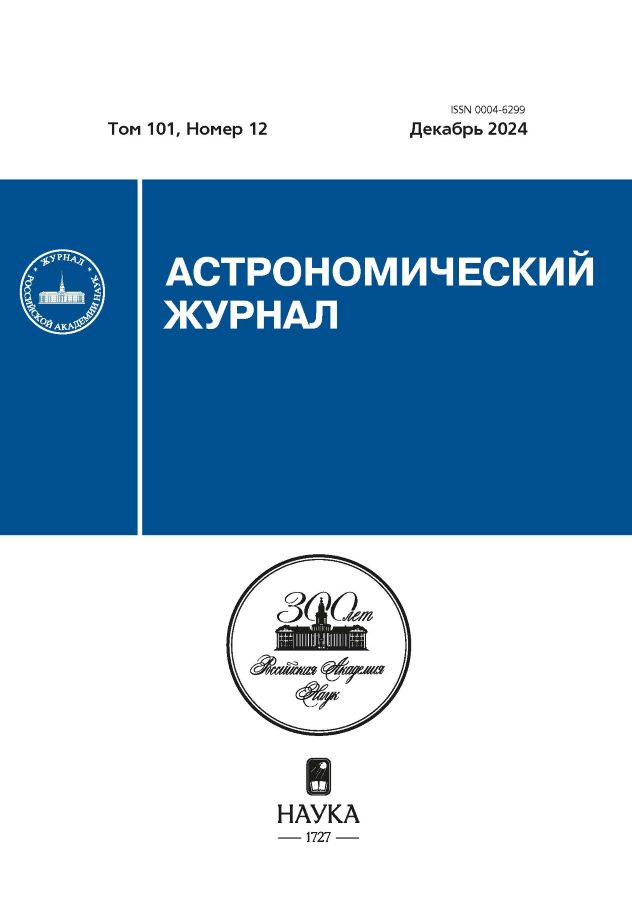To the question of north-south asymmetry of solar activity in the 25th Schwabe-Wolf cycle
- Autores: Yazev S.A.1,2, Isaeva Е.S.1, Tomozov V.M.2, Ivanov K.I.1, Hos-Erdene B.1,3
-
Afiliações:
- Irkutsk State University
- Institute of Solar-Terrestrial Physics of the Siberian Branch of the RAS
- Institute of Astronomy and Geophysics MAS
- Edição: Volume 101, Nº 12 (2024)
- Páginas: 1107-1116
- Seção: Articles
- URL: https://ruspoj.com/0004-6299/article/view/647690
- DOI: https://doi.org/10.31857/S0004629924120086
- EDN: https://elibrary.ru/IBVUPZ
- ID: 647690
Citar
Texto integral
Resumo
An analysis of the north-south asymmetry (NSA) of the groups of sunspots and flares location during the growth phase of the 25th Schwabe-Wolf cycle of solar activity was performed. During the first four years of the cycle’s development, sunspot activity increased quasi-synchronously in the northern and southern hemispheres; the module of the NSA coefficient during this period decreased from 0.6 to 0.2. The longitudinal distribution of sunspots in the second half of 2023 was uneven and similar in both hemispheres; groups of sunspots appeared during this period mainly in the longitudinal intervals of 30–100°, as well as 200–280°, at other longitudes activity was reduced, as in the northern, and in the southern hemispheres. The number of flares of all classes was 45% in the northern hemisphere, 42% in the southern hemisphere, 13% were not identified. The flare index was distributed between the hemispheres in the ratio of 49.5% to 42%, 8.5% were not identified. A comparison with the 24th cycle shows that NSA in the distribution of sunspots and flares between the northern and southern hemispheres in the current (25th) cycle is significantly lower than in the previous one. A high degree of symmetry of activity can ensure a greater height of the 25th cycle compared to the 24th, as well as the single-peaked nature of the 25th cycle. It is hypothesized that in the 25th cycle there is a higher level of dipole parity of the global magnetic field compared to the 24th cycle.
Palavras-chave
Texto integral
Sobre autores
S. Yazev
Irkutsk State University; Institute of Solar-Terrestrial Physics of the Siberian Branch of the RAS
Autor responsável pela correspondência
Email: syazev@gmail.com
Rússia, Irkutsk; Irkutsk
Е. Isaeva
Irkutsk State University
Email: syazev@gmail.com
Rússia, Irkutsk
V. Tomozov
Institute of Solar-Terrestrial Physics of the Siberian Branch of the RAS
Email: syazev@gmail.com
Rússia, Irkutsk
K. Ivanov
Irkutsk State University
Email: syazev@gmail.com
Rússia, Irkutsk
B. Hos-Erdene
Irkutsk State University; Institute of Astronomy and Geophysics MAS
Email: syazev@gmail.com
Rússia, Irkutsk; Ulaan-Baatar, Mongolia
Bibliografia
- N.V. Zolotova, D.I. Ponyavin, N. Marwan, J. Kurths, Astron. and Astrophys. 503, 197–201 (2009).
- S.V. Olemskoy, L.L. Kitchatinov, Astrophys. J. 777, 1, 71–79 (2013).
- Л.Л. Кичатинов, А.И. Хлыстова, Письма в АЖ 40, №10, 729–732 (2014).
- Yu.A. Nagovitsyn, A.I. Kuleshova, Geomagnetism and Aeronomy 55, 7, 887–891 (2015).
- D. Ratul, G. Aparup, B.K. Bidya, Monthly Not. Roy. Astron. Soc. 511, 1, 472–479 (2022).
- L.L. Kitchatinov, A.I. Khlystova, Astrophys. J. 919, 1, 36–45 (2021).
- Плазменная гелиогеофизика (М.: ФИЗМАТЛИТ, ред. Л.М. Зеленого, И.С. Веселовского, том 1, 672, 2008).
- В.Н. Обридко, Ю.А. Наговицын Солнечная активность, цикличность и методы прогноза (СПб.: Изд-во ВВМ, 466, 2017).
- Sunspot Index and Long-term Solar Observations: https://www.sidc.be/SILSO/datafiles.
- Сайт Лаборатории солнечной астрономии ИКИ и ИСЗФ: www.xras.ru.
- В.Н. Ишков Солнечная и солнечно-земная физика (СПб.: Изд. ВВМ, ред. Ю. А. Наговицын, 111–114, 2013).
- O. Andreeva, Advances in Space Research 71, 4, 1915–1921 (2023).
- S.V. Latyshev, S.V. Olemskoy, Astronomy Letters 42, 7, 488–494 (2016).
- A.S. Shibalova, V.N. Obridko, D.D. Sokoloff, Astronomy Reports 60, 10, 949–953 (2016).
- A.V. Zhukova, D.D. Sokoloff, V.I. Abramenko and A.I. Khlystova Adv. in Space Research, 71, 4, 1984–1994 (2021).
- С.А. Язев Феномен комплексов активности (Иркутск, изд-во ИГУ, 377, 2014).
Arquivos suplementares
















